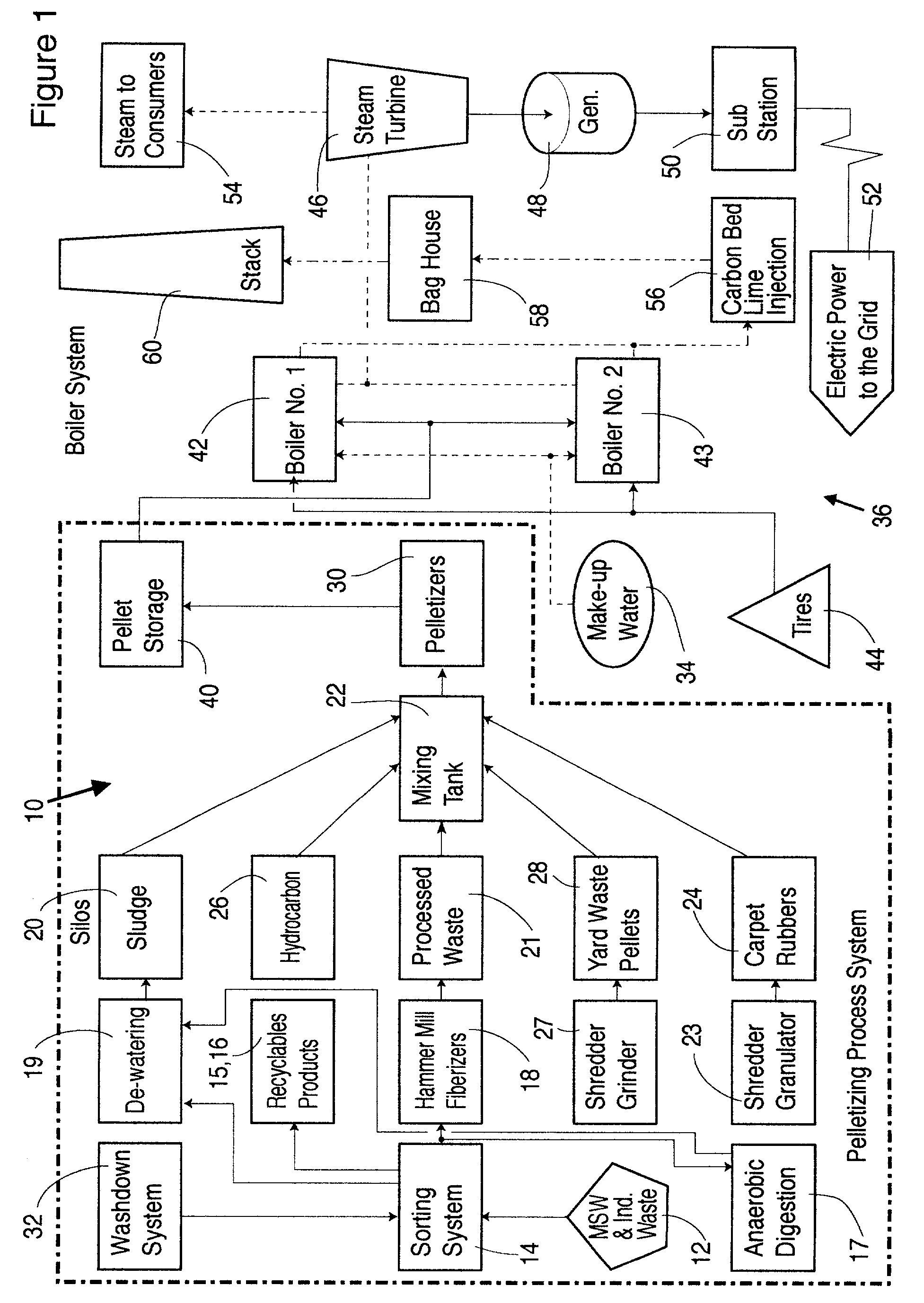Conversion of municipal solid waste to high fuel value
a technology of municipal solid waste and high fuel value, which is applied in the direction of biofuels, fuels, waste based fuels, etc., can solve the problems of fly ash production, increase in the amount of municipal solid waste and other waste generated each year, and the burning of raw municipal solid waste also creates heavy metal emissions, so as to achieve high fuel value and increase fuel value
- Summary
- Abstract
- Description
- Claims
- Application Information
AI Technical Summary
Benefits of technology
Problems solved by technology
Method used
Image
Examples
example 1
[0089]Municipal solid waste was processed using apparatus similar to that shown in FIGS. 2-5. In the process, municipal solid waste was mixed with various high BTU value wastes to yield a pellet having a composition as listed in Table 1. In one embodiment, the pellet obtained had a BTU value of 10,515 BTU / lb.
[0090]
TABLE 1ProductBTU / lbPer %ValueMSW8,000645,120Hydrocarbons16,000182,880Carpet16,500111,815Wood10,0007700Total10010,515
[0091]The pellets of the type described above were analyzed and then incinerated at a temperature of approximately 1100° C. The results obtained are given in Table 2.
[0092]
TABLE 2DescriptionPelletizedLooseMoisture Content% Weight4.419.37Volatile Matter% Weight69.4834.35Fixed Carbon1% Weight12.9453.75Ash2% Weight3.172.53Fuel ValueBTU / lb10500110221Includes the residual carbon left (part of bottom ash) after pellet combustion.2Includes both bottom ash and fly ash.
[0093]This example shows that pellets having a BTU value of greater than 10000 BTU / pound could be o...
example 2
[0094]Municipal solid waste was processed using apparatus similar to that shown in FIGS. 2-5. In the process, waste was mixed with various high BTU value wastes to yield a pellet having a composition as listed in Table 3. The pellets obtained had a BTU value of 13,970 BTU / lb. The pellet's moisture content was 6% and the bottom ash produced from combustion of this pellet was 4%.
[0095]
TABLE 3ProductBTU / lbPer %ValueMSW8,000413,280Hydrocarbons16,000142,240Carpet16,500142,310Granulated22,000143,080RubberAutomobile18,000173,060InsulationTotal10013,970
example 3
[0096]Municipal solid waste was processed using apparatus similar to that shown in FIGS. 2-5. In the process, municipal solid waste was mixed with various high BTU value wastes to yield a pellet having a composition as listed in Table 4 and having a BTU value of 12,580 BTU / lb. The pellet's moisture content was 6% and the bottom ash produced from combustion of this pellet was 4%.
[0097]
TABLE 4ProductBTU / lbPer %ValueMSW8,000534,240Hydrocarbons16,000111,760Carpet16,500121,980Granulated22,000112,420RubberAutomobile18,000111,980InsulationWood10,0002200Total10012,580
PUM
| Property | Measurement | Unit |
|---|---|---|
| temperature | aaaaa | aaaaa |
| width | aaaaa | aaaaa |
| width | aaaaa | aaaaa |
Abstract
Description
Claims
Application Information
 Login to View More
Login to View More - R&D
- Intellectual Property
- Life Sciences
- Materials
- Tech Scout
- Unparalleled Data Quality
- Higher Quality Content
- 60% Fewer Hallucinations
Browse by: Latest US Patents, China's latest patents, Technical Efficacy Thesaurus, Application Domain, Technology Topic, Popular Technical Reports.
© 2025 PatSnap. All rights reserved.Legal|Privacy policy|Modern Slavery Act Transparency Statement|Sitemap|About US| Contact US: help@patsnap.com



